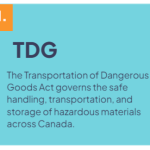The Transportation of Dangerous Goods (TDG) Act and Regulations form the cornerstone of Canada’s framework for ensuring the safe and secure transportation of hazardous materials. Enacted to protect public safety, property, and the environment, these regulations apply to all modes of transport—road, rail, air, and marine. Here’s a simplified summary of the key elements and requirements of the TDG Act and Regulations.
Overview of the TDG Act
The TDG Act is the primary legislation governing the transportation of dangerous goods in Canada. Its main objectives are to:
- Promote Public Safety:
- Prevent accidents and incidents involving dangerous goods that could harm people, property, or the environment.
- Harmonize Regulations:
- Align Canadian regulations with international standards to facilitate trade and transportation.
- Enhance Security:
- Address security concerns related to the transportation of dangerous goods, particularly those that could be used in terrorist activities.
View Transport Canada site to access TDG Act or Regulations.
Classification of Dangerous Goods
Dangerous goods are classified into nine classes based on their hazardous properties:
Explosives: Substances that can cause explosions (e.g., fireworks, ammunition).
Gases: Compressed, liquefied, or dissolved gases (e.g., propane, helium).
Flammable Liquids: Liquids that can catch fire easily (e.g., gasoline, alcohol).
Flammable Solids: Solids that can catch fire easily (e.g., matches, certain chemicals).
Oxidizing Substances: Materials that can cause or enhance the combustion of other materials (e.g., hydrogen peroxide).
Toxic and Infectious Substances: Materials that can cause harm to health (e.g., pesticides, medical waste).
Radioactive Materials: Materials that emit radiation (e.g., certain medical isotopes).
Corrosives: Materials that can corrode metals or cause severe damage to skin (e.g., acids, bases).
Miscellaneous Dangerous Goods: Hazardous materials that don’t fit into the other categories (e.g., asbestos).
Key Requirements of the TDG Regulations
Packaging and Containment:
Dangerous goods must be properly packaged in containers that meet specified standards to prevent leaks or spills during transportation.
Packaging must be durable and appropriate for the type of dangerous goods being transported.
Labelling and Placarding:
All containers must be labelled with the appropriate hazard symbols and information to indicate the type of dangerous goods they contain.
Vehicles transporting dangerous goods must display placards on all sides indicating the class of dangerous goods being carried.
Documentation:
Shippers must provide a shipping document that accompanies the dangerous goods throughout the transportation process. This document includes essential information such as the proper shipping name, class, UN number, and emergency contact details.
Carriers must ensure that the shipping document is readily accessible in the event of an emergency.
Training:
Individuals involved in the handling, offering for transport, or transporting dangerous goods must be adequately trained and hold a valid TDG certificate.
Training programs should cover the classification, packaging, labelling, documentation, and emergency response procedures for dangerous goods.
Emergency Response Assistance Plans (ERAPs):
For certain high-risk dangerous goods, an ERAP must be in place. This plan outlines specific procedures for dealing with incidents involving these goods and must be approved by Transport Canada.
Carriers must have access to the ERAP and be prepared to implement it in case of an emergency.
Enforcement and Penalties
Transport Canada is responsible for enforcing the TDG Act and Regulations. Inspections and audits are conducted to ensure compliance. Non-compliance can result in severe penalties, including fines and imprisonment. Ensuring compliance is crucial not only for avoiding legal consequences but also for maintaining public safety and environmental protection.
Conclusion
The TDG Act and Regulations are vital for the safe and secure transportation of dangerous goods in Canada. By adhering to these regulations, businesses and individuals can help prevent accidents, protect public health, and safeguard the environment. Understanding and complying with these requirements is essential for anyone involved in the transportation of hazardous materials or dangerous goods.












